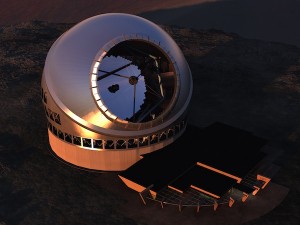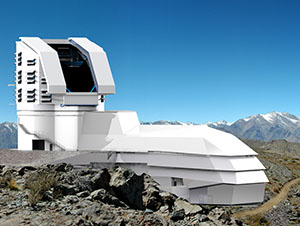main content begins
ALMA is one of the largest, ground-based astronomical facilities ever built. The array of 66 antennas is located on the Chajnantor plateau in northern Chile, at an altitude of 5000 metres. Observations made with individual antennas—separated by as much as 16 kilometres—are combined using a technique called interferometry, resulting in much higher-resolution observations than would be possible with a single antenna; the resulting resolution equals that of a radio dish with a diameter equal to the distance between interferometric antennas. Using ALMA, astronomers observe clouds of cold gas and dust in the millimetre/sub-millimetre range, studying star formation, planetary-system formation, and chemistry in space. The project, which completed construction in March 2013, is an international collaboration between Europe, East Asia and North America in cooperation with Chile. Credit: ESO/C. Malin.

The Algonquin Radio Observatory, located in central Ontario, is home to the 150-foot (46m) radio dish where decades ago the technique of Very-Long-Baseline Interferometry (VLBI) was invented. Using VLBI, astronomers combine disparate telescopes into single instruments with effective diameters comparable to the diameter of the Earth. Following a brief closure in the last decade, ARO has reopened under private management, and University of Toronto astronomers, postdocs and graduate students have been working to re-commission the 46m dish with new receivers and signal processing backends.
U of T astronomers, including Professor Keith Vanderlinde, are conducting an ongoing VLBI observing program using the ARO and GMRT (below) in an attempt to measure the mass of a neutron star 3000 light-years from Earth. Image: Prof. Keith Vanderlinde; Dunlap Institute
ASKAP is a next-generation radio telescope comprising an array of 36, 12-metre wide antennas at the Murchison Radio-astronomy Observatory in Western Australia. It is designed to observe large areas of the sky with high sensitivity, making it suitable for surveys. ASKAP science goals include the investigation of cosmic magnetism, the formation and evolution of galaxies, pulsars and gravitational waves. As an SKA pathfinder instrument, it will also be used to test technologies used in the development of the SKA. (See SKA below.) ASKAP is being developed by CSIRO, Australia’s national science agency, with participation from scientists from the Netherlands, Canada, the US and universities across Australia. Image: CSIRO
CHIME is an innovative radio telescope being constructed near Penticton, B.C. which, since it began science operations in the fall of 2017, is mapping the largest volume of space ever surveyed. The map will include a three-dimensional swath of the Universe covering half the sky and with a depth of billions of light years. CHIME will observe radio signals from distant clouds of hydrogen from an epoch when dark energy began to play an important role in the evolution of the Universe. It will also be an excellent detector of radio pulsars and Fast Radio Bursts (FRBs).
The CHIME collaboration includes researchers from the Dominion Radio Astrophysical Observatory, the University of British Columbia, the University of McGill and the University of Toronto. At the Dunlap Institute, the team working on CHIME is led by Professor Keith Vanderlinde. Credit: CHIME Collaboration.
The mission of the GAIA spacecraft is to create a dynamic, three-dimensional map of the Milky Way Galaxy by measuring the distances, positions and proper motion of stars. To do this, the spacecraft employs two telescopes, an imaging system, an instrument for measuring the brightness of stars, and a spectrograph. Launched in 2013, GAIA orbits the Sun at Lagrange point L2, 1.5 million kilometres from Earth. By the end of its five-year mission, GAIA will have mapped well over one billion stars—one percent of the Galactic stellar population.
At the Dunlap Institute, Professor Jo Bovy is currently using data from GAIA’s second data release to investigate the dynamics of the Milky Way Galaxy. Credit: ESO/S. Brunier.
The Gemini Observatory consists of twin 8.1-meter diameter optical/infrared telescopes located on Mauna Kea in Hawai‘i and on Cerro Pachón in Chile. The are currently two of the largest, most advanced telescopes in the world. In 2015, astronomers commenced a survey of 600 nearby stars from Gemini South in Chile with the Gemini Planet Imager. GPI is an adaptive-optics imaging spectrograph designed to directly image Jupiter-size exoplanets around nearby stars.
The Gemini Observatory was built and is operated by a partnership of six countries including the United States, Canada, Chile, Australia, Brazil, and Argentina. Gemini was built and is operated by a partnership of six countries including the United States, Canada, Chile, Australia, Brazil, and Argentina.
Currently, the Dunlap Institute’s Professor Suresh Sivanadam is leading the development of an infrared spectrograph for the Gemini Observatory called the Gemini Infrared Multi-Object Spectrograph, or GIRMOS, which is designed to image four targets simultaneously and produce high angular-resolution and highly sensitive infrared images of the sky. Credit: Gemini Observatory.

Located near Pune, India, the GMRT is made up of 30, steerable antennas that are each 45-metres in diameter. The telescope is used to make interferometric observations with with 435 possible pairs of antennas and with a maximum distance between antennas of approximately 25km. Among other science, the GMRT is used to observe pulsars and the 21cm-line radiation from primordial neutral hydrogen clouds in order to study galaxy formation.
U of T astronomers are using the GMRT and the ARO (above) in an ongoing VLBI observing program. Like ASKAP, the GMRT is a pathfinder telescope that will be used in the development of technology for the SKA (below). Credit: GMRT.
The launch of the Hubble Space Telescope in 1990 marked the beginning of a new era in astronomy. Above the obscuring effects of the Earth’s atmosphere, it gave astronomers their clearest view of the Universe. It is one of NASA’s longest and most successful missions, producing hundreds of thousands of images that have helped increase our understanding of the cosmos, from the objects in our Solar System, to the first galaxies to form after the Big Bang. Credit: NASA.

The LSST is an 8.4-m optical and infrared telescope under construction on Cerro Pachón, Chile. Over the 10-year period 2022 to 2032, LSST will image 18,000 deg^2 of the sky in six bands, visiting every position about 800 times to reach a final co-added magnitude limit r = 27.5. LSST will be transformational for a wide range of topics in astronomy, including weak lensing, BAOs, supernovae, NEOs, stellar astronomy, galaxy evolution, Galactic structure and transients. LSST will also explore new frontiers in astronomy data management, producing 30 TB of data and approximately one million transient alerts per night.
The Dunlap Institute has recently signed a Memorandum of Agreement with the LSST Corporation (LSSTC), with the aim of providing membership and scientific access to LSST for Canadian astronomers. Dunlap Institute Director, Professor Bryan Gaensler, is Lead Investigator for the Canadian LSST consortium. Credit: LSST.

The MWA is located at the Murchison Radioastronomy Observatory in Western Australia, the future site of the SKA (below). It is an interferometric radio telescope with over 2000 separate antennas arranged in 128 groups of 16. The maximum distance between antennas is approximately 3km, and the entire array has a collecting area of roughly 2000 sq. metres. Capable of conducting large surveys as well as observing discrete targets, the MWA focuses on four science themes: observing the 21cm line of neutral hydrogen from the epoch when first stars and galaxies formed; surveying the southern sky for radio emission from within MW galaxy, enabling study of our galaxy’s magnetic field; searching for transient and variable sources like pulsars, X-ray binaries and neutron stars; and monitoring “space weather” caused by activity on the Sun.
Phase 2 of the MWA has now commenced operations, which has improved the angular resolution to sub-arc-minute levels, has improved the image sensitivity by a factor of ~10, and has improved the EoR sensitivity by a factor of ~3.
In June 2016, the University of Toronto became a member of the Murchison Widefield Array (MWA) consortium, with a seat on the MWA Board of Partners, with Dunlap director, Prof. Bryan Gaensler as the U of T representative. Image: Murchison Widefield Array
When completed, the Simons Observatory will provide a powerful means to study the Cosmic Microwave Background, Dark Matter, Dark Energy, neutrinos, galaxy clusters and the early, inflationary Universe.
It is being built in the high Atacama in Northern Chile on the current site of the Atacama Cosmology Telescope (pictured) and will comprise four different, microwave instruments.
In February 2018, Professor Renée Hložek became chair of the Collaboration Council of the Simons Observatory. Credit: Atacama Cosmology Telescope
The South Pole Telescope is a 10-metre diameter telescope, located at the US Antarctic Program’s Amundsen-Scott South Pole Station, that surveys the sky at microwave frequencies to study the Cosmic Microwave Background. The CMB is a snapshot of the very young Universe, 380,000 years after the Big Bang and long before any stars or galaxies had formed. Among other observations, the SPT has made the most precise measurements of the small-scale properties of the CMB. The SPTpol polarization-sensitive camera mapped the polarization properties of the CMB.
In late 2017, Prof. Keith Vanderlinde and colleagues completed their work on SPT-3G, an upgrade to the telescope camera. And in the winter of 2017/28, U of T astronomy graduate student Matt Young spent two months at the South Pole helping to install the new instrument. Image: Prof. Keith Vanderlinde; National Science Foundation
When completed in the mid-2020s, the SKA will be the largest radio telescope ever built, with a total collecting area of over one square kilometre. The array will be made up of several thousand 15-metre diameter radio dishes, along with several thousand antennas, located in South Africa and Australia. It will perform as a single, intercontinental radio telescope, or many smaller ones; and long-baseline interferometry will result in observations with 50X the resolution of the Hubble Space Telescope. The SKA will combine this resolving power with unprecedented sensitivity as well as the ability to image huge areas of the sky. Astronomers will have an extraordinary new tool with which to conduct new tests of General Relativity; observe star and galaxy formation in the very early Universe; and investigate dark energy, cosmic magnetism. SKA will even be used in the Search for Extraterrestrial Intelligence (SETI).
The international effort currently includes Canada and 9 other member countries. For more on Canada’s role in the SKA, visit the SKA Canada website. Image: SKA Organisation
When it begins operation on Mauna Kea, Hawaii, early in the next decade, the Thirty Meter Telescope When it begins operation on Mauna Kea, Hawaii, early in the next decade, the Thirty Meter Telescope will be the largest, most powerful optical telescope on the planet. Its 30-metre primary mirror will gather nine times as much light as a single Keck primary mirror, and its adaptive optics system will compensate for the atmosphere’s effect on seeing, thereby optimizing the telescope’s performance. Image: TMT International Observatory
